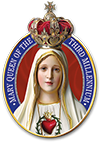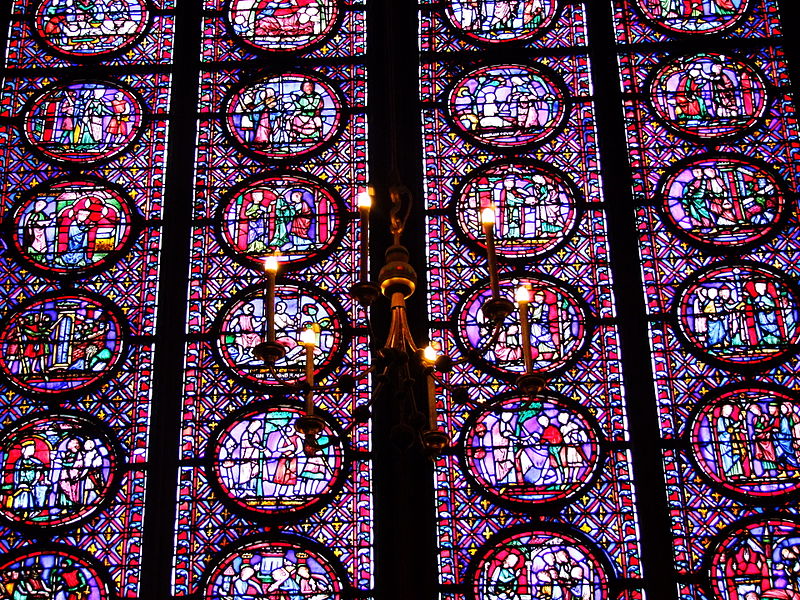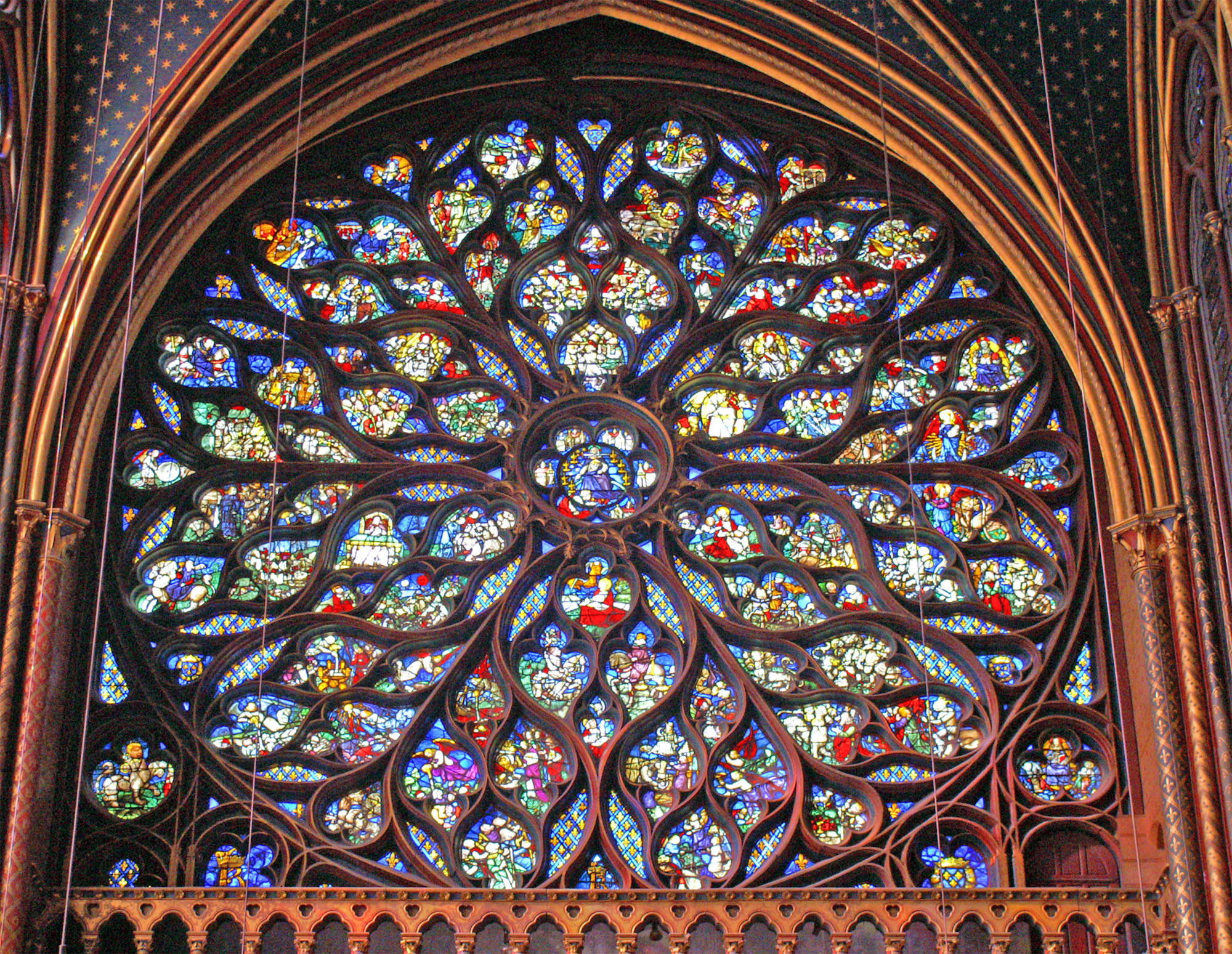Its graciousness soothes the soul, its verticality lifts hearts; the marvelous colors of the stained glass purify the mind. Its ogives point to the right path and its light silences the power of darkness. Sinners find conversion; the faithful, refuge; and poets, inspiration. It is the Gothic style…
Paris was at its apogee. In the mid-thirteenth century everything seemed to converge toward a cultural and spiritual apex. The faithful flocked to hear the preaching of the friars of the mendicant orders, Dominicans and Franciscans; theology students admired the doctrine expounded by St. Thomas Aquinas; civil society witnessed the ascension of the great King Louis IX, adorned with the royal insignia and especially the crown of holiness. God’s blessing seemed to pervade every heart.
Nature harmonized with society in the City of Light. Fields and mountains were dotted with towers and fortresses. On the Île de la Cité, at the very heart of the town, two marvels of Gothic construction stood out: Sainte Chapelle and Notre-Dame Cathedral, the geographical center and hub of Paris’ spiritual life. But not everyone patronized the Cathedral…
The story of Jacques, the shoemaker
The story is told of a certain shoemaker named Jacques who, in his youth, had fallen away from religion. He was so miserly and had become so corrupted through bad friendships, that his heart seemed insensible to divine things. But nothing can extinguish from the human soul the desire for the Absolute, the link of our relationship with God and the key to conversion.
Providence arranged that Jacques have a privileged view from his window of the newly built towers of Notre-Dame. His thirst for the Absolute harmonized with that sacred symbol, sparking the desire to see them up close and understand their deeper meaning. But the stain of sin clouded his intelligence and dragged his will toward evil: he had time for money, but none for Mass. He was a strong worker, but a flaccid Christian. He longed to visit the cathedral, but human respect prevailed.
One day, while passing through the city centre, Jacques found himself before the majestic shrine, bathed in a dazzling sunset. A feeling of awe welled up in his soul, and the dilemma resurfaced:
“Now… Do I enter?”—prompted the voice of grace.
“Or should I not enter?”—came the temptation of the prince of darkness.
Hesitatingly he approached the central portico, encircled by the representation of the Final Judgement. As he paused to reflect on the scene, admiration, curiosity and fear stirred within him, finally drawing him, step by step, into the sacred precinct.

He walked slowly down the main nave, contemplating the mass of sculpted stone and the polychromatic glow of the stained glass. He paused before the window at the northern transverse, in ecstasy. It represented the figure of St. John the Evangelist, which, in a way impossible to explain, came to life and said to him: “The lights and colors that you see are expressions of divine perfection. Look within yourself and there you will find even more color and more light.” Changed by this vision, Jacques made the decision to embrace the religious life, and in fact lived out the rest of his days as a monk.
Whether fact or fancy, this story portrays the action of grace through stained glass, and introduces us to the profound theological meaning of the lights that illuminated the shoemaker of our tale, bringing about his conversion. For Gothic architecture is based on what is called the “metaphysics of light”.
In the Basilica of Saint-Denis
“Nothing great happens suddenly,” goes the saying. This can also be applied to the emergence of gothic art.
The tomb of St. Dionysius (SaintDenis), first Bishop of Paris, which dates to the third century, lies in the north of Paris approximately ten kilometers from Notre-Dame. Over time, this official necropolis for French sovereigns became a busy pilgrimage site, its first devotee being King Dagobert I (†639). Adjacent to the Basilica is the Benedictine Abbey of the same name, considered to be one of the most important of the Middle Ages. Gradually, the Saint-Denis complex harmonized its spiritual destiny with that of the French monarchy, thereby acquiring considerable prestige and preeminence.
At the beginning of the twelfth century, Saint-Denis underwent the problems inherent to secularization while under the direction of the Abbot Adam. Upon his death in 1122, Suger succeeded him—a man sent by God, according to his principal biographer, “to illuminate not only the site, but the entire empire of the Franks.”1 The use of this verb is most appropriate, since the new superior, in addition to enriching Saint-Denis with new rays of material light through gothic art and liturgical splendor, also brought spiritual light to the Abbey, and later, to all of France. Sufficient evidence of this is that between the years 1180 and 1270 alone, 80 gothic cathedrals were built in this country, not counting abbatial churches and other religious edifices.2
Ever since Suger’s entrance into Saint-Denis as an oblate at just ten years of age, the idea of establishing a new art progressively ripened in his soul. He dreamt of reforming the Basilica. His monastic formation played a significant role in the elaboration of his plan, especially the reading of the work Celestial Hierarchy, in which Dionysius (†sixth century), while treating of the angels, develops what he called the “metaphysics of light”.
Metaphysics of light
Someone might suppose material light to be a merely physical phenomenon, devoid of a relationship with God or with the supernatural. Yet its untouchable, diaphanous and pure quality, and the fact that it is essential to life, allows it to somehow reflect the supernatural. And conversely, the spiritual tends to manifest itself in luminosity, as the Bible and private revelations attest. In other words, light came to be understood as a type of bridge between the natural and the supernatural.
Light has its origin, as do all things, in God himself. In the Psalms, He, immaterial Being, is compared with the sun that illumines us (cf. Ps 37:6; 43:3) and makes His face shine upon us (cf. Ps 67:1). The Church Fathers corroborate this idea, using similar expressions. St. Hilary, for example, calls God “all light”;3 for St. Ambrose, He is “eternal splendour”;4 and for St. Augustine, the “spiritual sun”.5
In short, God is Light in essence and the “Father of lights” (Jas 1:17). In fact, this paternity is well expressed by Creation itself as a luminous act: “God said: ‘Let there be light;’ and there was light” (Gn 1:3). From a theological perspective, the Creator, in giving existence to beings, “illuminates them” in proportion to a greater or lesser similarity with Him. Something analogous takes place with fire: objects take on greater or lesser heat depending on their proximity to it. Thus, the closer a being is to God, the more illuminated it is, and vice-versa.
Now, this greater or lesser illumination of creatures by reason of their greater or lesser distance from God is very much linked to the theory of beauty. According to the philosophy of Dionysius, the manifestation of light—that is, clarity (claritas) and splendour (splendor)—is a fundamental and objective quality of beautiful things, because all of them are, lato sensu, illuminated in some way. This may be confirmed by our own aesthetic experience: is it not true that we become awe-struck when we contemplate a beautifully illuminated landscape, the brilliance of the stars or the crystalline water of a cascade? Moreover, beauty is directed, above all, to the spiritual or the intellectual. This is why we call those who possess spiritual beauty “sons of light”; prophetic inspirations, “divine illuminations”, and someone with clear ideas, “lucid”.

For God is the “true Light” that “enlightens every man” (Jn 1:9), directly or through “material lights” that He offers us.
How does this illumination occur?
St. Paul’s words concerning the knowledge of God through creatures have become immortalized. “His invisible nature,” he affirms, “has been clearly perceived in the things that have been made” (Rom 1:20). In other words, the contemplation of the wonders of Creation favors knowledge of the Creator and His attributes. This occurs symbolically (συμβολικῶς), that is, through visible signs we can know the invisible; and anagogically (ἀναγωγικῶς), when, by means of natural things we are lifted up to the supernatural.6 In this sense, St. Thomas Aquinas compares us to owls incapable of looking directly at light.7 This is why, while sojourners on earth, we must turn to what is connatural to us to attain such knowledge.
However, this elevation to God does not happen only through Creation pure and simply. It can be aided through poetic Scriptural images or from metaphors that express wonders or the supernatural, which surpass our experimental knowledge. In fact, when symbols denote superior realities, they curb our natural inclination for the material, favoring the superior part of the soul which naturally aspires to higher things.8 This explains the importance of art as a means of expressing divine attributes.
The Gothic style, as we shall see, possesses a profoundly symbolic character, in the sense just mentioned. But its importance particularity rests in its extraordinary effectiveness for transposing the metaphysics of light into matter.
From theology to art, from art to God
The theology that we have commented here is revealed in the accounts of Suger concerning the reform of the Basilica of Saint-Denis: one on its consecration (De consecratione) and the other on administration (De administratione).
After organizing the Abbey according to the Benedictine rule, Suger went on to improve the Basilica, by increasing its liturgical splendor and its acquisition of goods, while always avoiding superfluity and excess.
Later arose the work that would gain him the honorable title of “founder of the gothic style”; the restructuration of the facade and the choir of the then Carolingian Basilica of Saint-Denis. Thanks to divine assistance and the dedication of clergy, nobles and the people—especially the best artists—the reform was completed in only three years and three months. The splendid consecration ceremony, on June 11, 1144,9 included the presence of the king and queen, in addition to the highest dignitaries of the clergy and nobility. In fact, judging by the accounts, it was a veritable prefigurement of the Kingdom of heaven.
The sublime liturgy harmonized with the majestic ambience provided by an imposing structure. To gain the desired light-filled setting, they culled architecture elements from Burgundy (ogival arches) and from Normandy (ribbed vaults), together with this project’s great structural innovation—flying buttresses— making up the principal components of the nascent gothic style. Indeed, this last invention, both ingenious and aesthetic, assured for the new work a strength and grandiose beauty that soon spread throughout all of France.10
Nevertheless, the Gothic style cannot be reduced to simply a style of architecture. Rather, as has been seen, it was clearly a true work of the theology of light transferred to matter. Its success was such that it achieved a veritable transfiguration in European religious art, whose fruits have reached the present day. For its predecessor, the Romanic style—due to its structure of rounded arches and thick walls—had not allowed for the introduction of large windows, with the evident result of reducing the sunlight that entered.
Herein lies the originality of Gothic art and its relationship with light. With the goal of obtaining greater luminosity, ogival arches were introduced, furnishing the edifice with finer walls, slender columns and higher ceilings. Finally, arranging the length, height and width in perfect proportion, the geometric beauty of Creation—laid out in “measure and number and weight” (Wis 11:20)—was translated into art.
In this way, without compromising the edifice’s structure, conditions were skillfully created for introducing larger stained glass windows and consequently, more light—the principal “construction material” for this art. Thus, the spiritual was incorporated by light, and God, “immaterial Light”, became “visible” in matter. And then there was light in architecture!
An illustrated theological treatise
These mosaics of translucent glass were evidently not limited to enabling the entrance of light. Besides the objective of allowing the entire Church to shine “with the wonderful and uninterrupted light of luminous windows pervading the interior beauty,”11 they also had a lofty aesthetic function. Furthermore, they were intended to portray scenes from the Gospel or the lives of the saints. This function was accompanied by another ingenuity of Suger in the Basilica of Saint-Denis: the creation of socalled “exegetic stained glass windows”.12 In these, art transcended the image by offering, moreover, an interpretation of Sacred Scripture.13 Accordingly, through a few images, observers were presented with a veritable illustrated theological treatise.
In fact, the most famous stained glass of Saint-Denis, known as “the anagogical window”, or better “the Pauline allegories window”, is composed of five medallions which represent, through typology and allegory, the concordance of the two testaments.14 For example, in one of the medallions, known as the “Mystic Mill”, St. Paul is shown receiving sacks of wheat coming from the Old Testament and pouring them into a mill. On the other extremity he withdraws the flour to make the “true bread […], our eternal and angelic food.”15
In another scene Our Lord is represented as He who strips the veil from Moses, whose face was until then covered before the Israelites, because in Christ the veil is removed (cf. II Cor 3:13-16); or, as Suger explains: “What Moses concealed, the doctrine of Christ revealed.”16
Finally, in perhaps the most well known medallion of all, God the Father is represented in the center of the allegories of the seven gifts of the Holy Spirit, flanked by two women, one a symbol of the Church, the other, of the Synagogue.
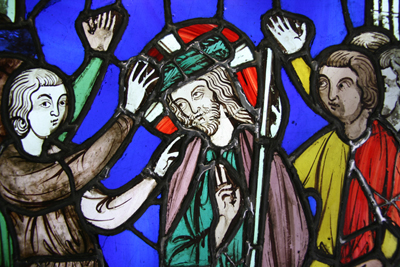
With the left hand, He removes the veil from the Synagogue, while with the right He crowns the Church. Thus, hitherto unknown reversibility in iconography were deciphered by a simple “illustration” (a word, by the way, derived from the Latin word illustrare, which means “to clarify, illuminate”).
Therefore, the stained glass windows fulfilled an important pedagogic function of “illustrating”, which is summed up in the famous expression “Bible of the poor”. They had the excellent capacity of “conferring to matter the highest treasures of work which transforms it and confers to images the preciousness of intellectual speculation.”17
Light and splendor in the house of God
The splendor of the Basilica’s illumination is not due only to its precious stained glass—especially those colored blue, of a sapphire-like beauty—but also to the use of metals and jewels for the ornamentation of the Church and its objects.18 In fact, Suger thanks the divine munificence for having adorned it with “gold, silver, most precious gems and very good textiles.”19 Furthermore, he employed the best painters of the various regions so as to furnish the walls with “gold and precious stones.”20
Thanks to his efforts, in this church erected like a monumental kaleidoscope, “having the glory of God” (Rev 21:11), the light from the windows harmonizes with the splendor of the divine worship, the material with the immaterial, the corporal with the spiritual, the human with the divine. In sum, by way of the ogive, Suger sought to promote the true encounter between heaven and earth into just one state,21 to build “the new Jerusalem” mentioned in Revelation (21:2).
Having in mind Dionysius’ “metaphysics of light” and his theory regarding the properties of stones, allied to the narration of Revelation (21: 19-21) and of Ezekiel (28:13), Suger, “out of love for the beauty of the house of God,”22 transposed philosophy and Revelation into matter, employing various types of stones in the temple and liturgical objects: “sardonyx, topaz, jasper, chrysolite, onyx, beryl, sapphire, carbuncle and emerald.”23
In the end, man can, through aesthetic experience, pass from the contemplation of “material lights”— stained glass, precious stones, gold, pearls, etc.—to the “immaterial Light”, or better yet, one is “transported, by the grace of God, from this inferior [world] to the superior in an anagogic manner.”24 This represents the marvelous convergence between the metaphysics of light and Christian art.
Of what use is art?
In the medieval world-view, the universe was understood as a book written by God, whose “words” take us back to the Author. On the other hand, these “words” can form still others through human ingenuity, according to the idea expressed by Dante, that a work of art is a “grandchild of God”.25
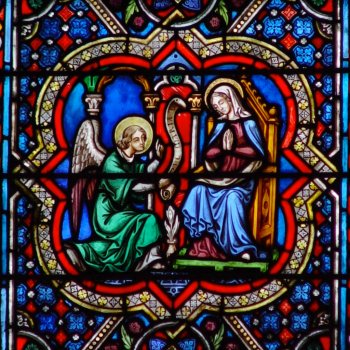
Thus, for Suger, technology placed at the service of divine worship must do everything in the most perfect manner possible, “so that people might say: ‘the workmanship surpassed the material.’”26 In this way, religious art should never seek to serve itself (ars gratia artis); to adorn a church means to adorn the very Bride of Christ,27 and ultimately, to render praise to the Supreme Artist.
Now, if in the holocausts of the Old Law, objects of great value were employed to collect the blood of sacrificed animals, how much more appropriate is it that “golden vessels, precious stones and whatever is most valued among all created things be laid out for the reception of the Blood of Jesus Christ.”28 Indeed, for the Holy Sacrifice of the Mass, complete interior purity and exterior nobility is required, because our Redeemer must be served in a whole and universal manner.29
This interior purity means that the aesthetic proposed by the Abbot of Saint-Denis also possesses a clear objective of moral perfection; namely, in uniting itself to the beautiful, our soul itself becomes beautiful. And the more material things are conformed to Divine Beauty, the more our soul, in contemplating them, is illuminated by the “Father of lights”. Conversely, the more we suppress beauty in art, or are darkened by the stain of sin, the further removed we are from the first Light. In fact Suger anathematizes anyone who “destroys the illustrious altar: May they suffer the same condemnation of Judas.”30
This moral reflection is well summarized by the verses from the porticos of the Basilica of Saint-Denis: “Bright is the noble work; but, being nobly bright, the work should brighten the minds, so that they may travel, through the true lights, to the True Light where Christ is the true door. The dull mind rises to Truth through material things and, in seeing this light, is resurrected from its former submersion.”31 The gothic style is therefore the “archetypical expression of the Christian soul.”32
In sum, art can lead to holiness when it is in accord with God; and to corruption, when the contrary prevails. And where does the gothic style lead us?
What light do we seek?
Gothic architecture harmoniously unites strength and elegance, simplicity and sophistication, proportion and clarity, drawing together heaven with earth, and with its daring heights, leads man to pay attention to “material lights” that point toward the True Light.
Its graciousness soothes the soul, its verticality lifts hearts, the marvellous colours of the stained glass purify the mind. Its ogives point to the right path, its stones preach with compelling silence, its light silences the power of darkness. Sinners find in it conversion; the faithful, refuge; and poets, inspiration.
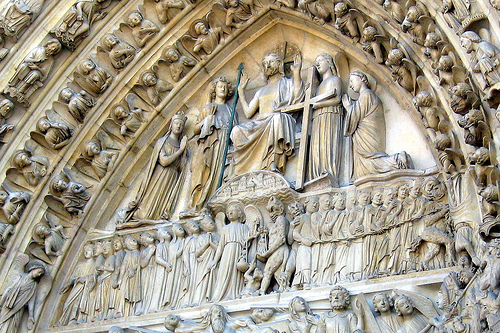 We see that light, guided by theology, pervaded art; distinguishing material qualities, and caused the supernatural to shine through; through its cathedrals, the gothic style covered medieval European lands like a mantle; by its application of symbols we are invited to see the true Light: In lumine tuo videbimus lumen (Ps 35:10).
We see that light, guided by theology, pervaded art; distinguishing material qualities, and caused the supernatural to shine through; through its cathedrals, the gothic style covered medieval European lands like a mantle; by its application of symbols we are invited to see the true Light: In lumine tuo videbimus lumen (Ps 35:10).
Destined to mark the history of art with unparalleled brilliance, the gothic style not only calls for a reflection on its material object, but its eminent characteristics also incite the spirit to seek supernatural realities. By its symbols and moral strength, by its goodness clothed in beauty, it discreetly touches our conscience.
Is it not true that when we cross a gothic threshold or that of any dignified church, we become immersed in another world, far from today’s hectic pace? There, worldly messages yield to the simplicity of the ex-votos. Gaudy neon lights are changed for the filtered colours of stained glass. Exhaust fumes give way to the perfume of incense. The mechanical din is substituted by an enveloping silence, interrupted only by liturgical voices or murmured prayers, or even the instinctive whispering of the faithful, who were anonymous outsiders, but once within, feel united by an inexplicable intimacy, like children of the same Father.
Does this picture awaken admiration or aversion in us?
It is up to the reader to reflect and conclude. What is certain is that the “material lights”, as we have seen, are excellent means to follow the path of Christ; an invitation for us to become luminaries in the world, far from darkness (cf. Phil 2:15; 1 Jn 1:5-7) to the supreme meeting with Him in the heavenly homeland when “night shall be no more; they need no light of lamp or sun, for the Lord God will be their light, and they shall reign for ever and ever” (Rev 22:5).
Our hope, above all else, is this that this light may shine for us.
1 GUILHERME DE SAINTDENIS. Vita Sugerii, I. In: SUGER. OEuvres . París: Les Belles Lettres, 2008, v. II, p. 297.
2 Cf. TOMAN, Rolf (ed.). Gothic : Architecture, Sculpture, Painting . Koöln: Koönemann, 2004, p. 9.
3 SAN HILARIO DE POITIERS . Epistola seu libellus , V (PL 10, 737B).
4 SAN AMBROSIO. In Psalmum David CXVIII expositio , s.1 9, c. 38 (PL 15, 1481).
5 SAN AGUSTÍN. Sermone Domini in monte secundum Matthaeum Libri Duo , XXIII, 79 (PL 34, 1269).
6 Cf. DIONISIO AREOPAGITA. De cælesti hierarchia, c.I, 2. In: Corpus Dionysiacum II . Ed. G. Heil and A.M. Ritter. Berlin: De Gruyter, 1991 (Patristische Texte und Studien 36), p. 7. l. 13.
7 Cf. SANTO TOMÁS DE AQUINO. De malo , q. 16, a. 8, ad 2.
8 Cf. DIONISIO AREOPAGITA. De cælesti hierarchia, c. II, 3 In: Op. cit., p. 13, l. 16-18.
9 Cf. SUGER. OEuvres . París: Les Belles Lettres, 2008, v. I, pp. 12-14.
10 Cf. STANLEY, David. The Original Buttressing of Abbot Suger’sChevet at the Abbey of Saint-Denis. In: Journal of the Society of Architectural Historians. Califórnia: n. 3, v. LXV, set. 2006, pp. 334-355.
11 SUGER, op. cit, v. I, p. 26.
12 Cf. RUDOLPH , Conrad. Inventing the Exegetical Stained- Glass Window: Suger, Hugh, and a New Elite Art. In: The Art Bulletin , v. 93, 4, diciembre. 2011, pp. 399-422.
13 Cf. RUDOLPH, Conrad (ed.). A Companion to Medieval Art : Romanesque and Gothic in Northern Europe . Malden, MA: Blackwell, 2006, p. 180.
14 Cf. Ídem, ibídem. SUGER, op. cit., v. I, p. 148.
15 Ídem, ibídem.
16 GRODECKI, Louis. Etudes sur les vitraux de Suger à Saint-Denis . París: Presses de l’Université de París-Sorbonne, 1995, v. II, p. 74.
17 SUGER, op. cit, v. I, p. 150.
18 Ídem, p. 108.
20 Ídem, p. 110.
21 Cf. Ídem, p. 52.
22 Ídem, p. 134.
23 Ídem, ibídem.
24 Ídem, pp. 134.136.
25 Cf. DANTE ALIGHIERI. Infierno , XI, 97.
26 SUGER, op. cit., v. I, p. 132.
27 Ídem, p. 122.
28 Ídem, p. 136.
29 Cf. Ídem, p. 138.
30 Ídem, p. 132.
31 Ídem, p. 116.
32 CORRÊA DE OLIVEIRA, Plinio. Só a arte sacra pode ser cristã? In: Catolicismo. São Paulo: nº 24, diciembre. 1952.
